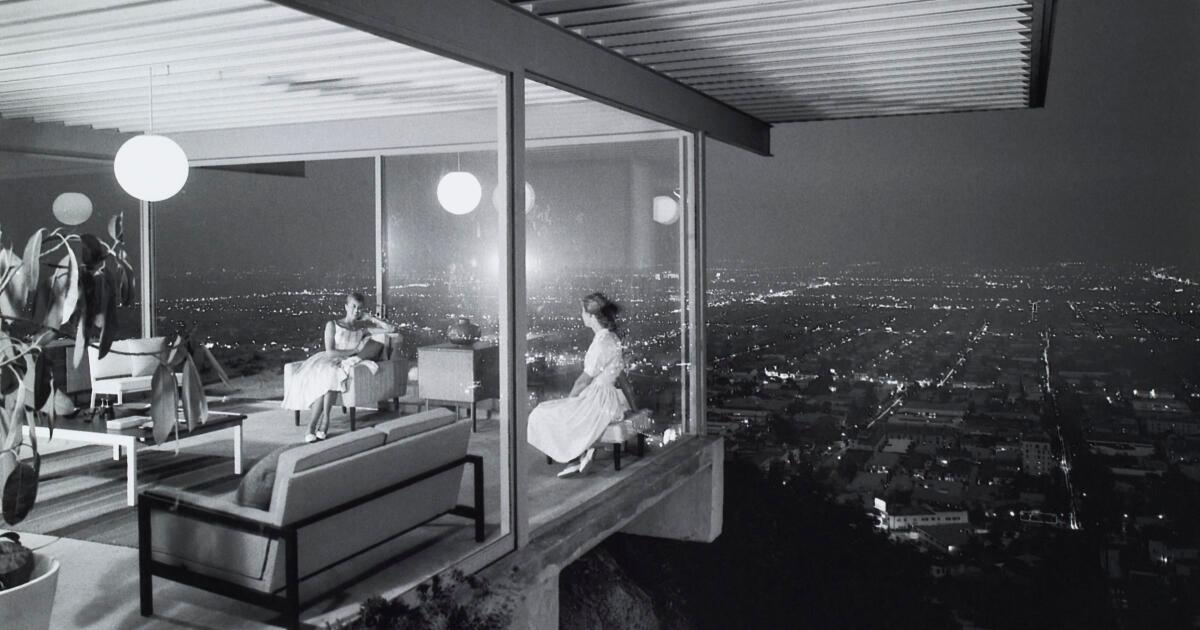For decades, the Stahl House in the Hollywood Hills has been a rarity — a globally known icon of Midcentury Modernism and Los Angeles glamour, still in the hands of the family who commissioned it in 1960. But now it’s for sale.
The asking price is $25 million, which might seem a startling figure for a two-bedroom, 2,300-square-foot home on a snug lot. But that figure might not surprise lovers of modernist architecture who know it as Case Study House #22.
It was designed for the Stahl family by architect Pierre Koenig, captured on black-and-white film by photographer Julius Shulman and has been admired worldwide ever since.
The Architect’s Newspaper called it “one of the world’s most famous buildings.” Los Angeles magazine called Shulman’s image “perhaps the most famous picture ever taken of Los Angeles.”
“There are no comps for the Stahl house. It’s incomparable,” said William Baker, architecture director for the real estate firm the Agency Beverly Hills. The home was included in the company’s fall catalog Nov. 12.
By Friday afternoon, Baker said, he had received hundreds of inquiring calls. In considering offers, Baker said, the family is open to individuals or institutions — “someone who’s going to understand it, honor the house and the story about it.”
The Stahls purchased the lot in 1954 for $13,500 and enlisted Koenig to design the house after other architects were daunted by the slope of the lot. Koenig’s solution was a cantilevered L-shaped structure with walls of steel and glass, a pool and a free-standing stone-faced fireplace between the living and dining areas.
The second bedroom can only be accessed through the primary bedroom — “an efficient use of space” for a family of five, Baker said. The Stahl family has said the home cost $37,500 to build.
Shortly after the home’s completion, photographer Julius Shulman made a black-and-white photograph that became emblematic of the era. It shows the home at night, with two young women sitting inside in a cantilevered corner, its floor-to-ceiling windows revealing the lights of the L.A. Basin glittering in the background.
To bring up the lights, Shulman later told Los Angeles magazine, he used a seven-minute exposure. The resulting image, along with others Shulman made of the house, is now owned by the Getty Research Institute.
In years since, the home has served as a filming location for many TV and film productions, including the 1968 pilot episode of “Columbo” and the movies “Galaxy Quest” (1999) and “Nurse Betty” (2000).
“This home has been the center of our lives for decades, but as we’ve gotten older, it has become increasingly challenging to care for it with the attention and energy it so richly deserves,” the Stahl family announced on its website. Bruce and Shari Stahl, the surviving children of original owners Buck and Carlotta Stahl, added, “[O]ur tour program will continue unchanged for the time being, and we will provide ample notice before any adjustments are made.”
For the last 17 years, the house has been open for tours, most recently on Wednesdays, Fridays and Saturdays, starting at $60 per adult during the day, $90 in the evening, with advance booking required and tight limits on photography. However, the Stahl website indicates all tours are sold out through the end of February.
The real estate listing notes that the home is “a protected landmark and the only Case Study House with original family ownership.”
In nominating it for the National Register of Historic Places in 2009, Amanda Stewart of the Los Angeles Conservancy called it “perhaps the most iconic house constructed in the Case Study House Program.” That program, sponsored by John Entenza’s Arts & Architecture magazine from 1945 to 1966, yielded 25 completed homes, today considered top exemplars of Midcentury home design.
“There’s not a lot of these Case Study houses left. I think there are 19 now,” Baker said. (Baker also said he had recently handled the sale of Case Study House #10 in Pasadena to a buyer who lost a home in January’s Pacific Palisades fire.)
The Stahl home stands on Woods Drive just north of West Hollywood’s city limit, about a quarter of a mile from Chateau Marmont.
Many architecturally important Southern California Modern homes have landed in the hands of institutions, including Frank Lloyd Wright’s Hollyhock House (1921), owned by the city of Los Angeles; the Schindler House (1922), owned by the Friends of the Schindler House and operated by the MAK Center for Art and Architecture; and the Eames House (1949), owned by the nonprofit Eames Foundation. The Sheats-Goldstein Residence, designed by John Lautner in 1961-63 and renovated by Lautner in the 1990s, has been promised by owner James Goldstein to the L.A. County Museum of Art.
This story originally appeared on LA Times

